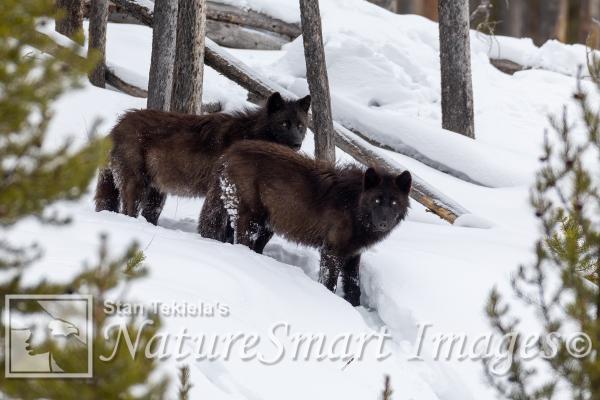View all of the titles in the
NatureSmart Bookstore

by Stan Tekiela
© NatureSmart
April 15, 2024
Just the day before, a pack of wolves known as the Wapiti, had found a large bull bison that was weak and injured. Based on its size, this big boy was near the end of its lifespan and the winter weather was taking its toll. For a full day the wolves tried to approach the bison but when the bison turned to defend itself, the wolves retreated for fear of being injured themselves. All of this took place along the Firehole River in Yellowstone this past week while I was leading a group of photographers on a photo adventure.
Large male bison often weigh over 2,000 pounds (one ton) and are extremely strong and powerful animals. The big males are the size and weight of a small automobile. Their hides are thick and covered with fur making it very difficult for a wolf to grab ahold or tear the flesh of a bison. On the other side, the average weight of a wolf is around 80 pounds and is considerably smaller than the bison.
The bison was along the banks of the river and often retreated into the water to escape the wolves. At some point the bison, too weak from the winter weather, simply put its head underwater and drowned. This was the break the wolves needed. The 10 or so wolves entered the river and started pulling on the bison. Eventually the current took the carcass downstream about a couple hundred yards and got caught up on a shallow spot in the river.
The day after the demise of the bison, I arrived with my group of photographers. We had heard all the details of the day before, so we were eager to get to the scene. Early morning in the dark, we piled into our snow coach, a massive vehicle with 48-inch all terrain tires and headed into the depths of the park. Arriving just after daybreak, we set up about 130 yards away from the half-eaten bison carcass in the river. A coyote was already there trying to strip off some meat from the water-soaked hide.
The weather was cooperating with us. The temperatures were right around freezing with no wind, so if you are dressed right, this makes for very comfortable conditions. While everyone was busy capturing images of the coyote, off to our left deep in the woods, the Wapiti pack was bedded down and resting out of sight.
A couple hours after we arrived, we spotted the first wolf making its way through the forest heading in our direction. The coyote, knowing better, vacated the carcass when it saw the approaching wolves. At first, we only saw one black wolf then a second. The two wolves who looked like siblings, stopped at the edge of the forest where a small stand of young fir trees where growing. They surveyed the area carefully before approaching the carcass.
The wolves standing on the edge of the forest gave us some wonderful opportunities to capture some iconic images. After a minute or two, they came down the small hill and crossed right in front of us to the river’s edge. The wolves walked right into the shallow and fast-moving river heading right to the carcass. A flock of Common Ravens had moved in on the carcass the second the coyote left so the wolves started to have some fun chasing them off by running through the water directly at the ravens.
At one point, three wolves, two black and one gray, were all feeding on the carcass in the river. Every now and then one would lift their head to look around, surveying the area directly around them to make sure they were safe. This allowed us to capture some amazing action shots and riveting video of the food chain in the wild.
One by one the wolves would come down out of the forest to our left, cross in front of us and walk into the river to our right. At one point, three of the black wolves gathered together and started to play fight with each other. This type of behavior being displayed right in front of us, insured me that we were in no way affecting the behaviors of the wolves. They were very comfortable with us and respectful of the distance we kept between us. After a while a couple of the wolves laid down for a few minutes, again showing they were not being disturbed by our presents.
The wolves fed for the better part of a couple hours before they retreated to the forest to sleep again. We hung out and ate our lunches while we waited and sure enough later in the afternoon the wolves woke from their naps and returned back down to the river to feed more, allowing us to capture even more incredible images.
Normally the moments we get with wolves are measured in minutes, not in hours and definitely not in a full day. This was an outstanding opportunity to see, photograph and learn the behaviors of one of the coolest animals in the world. Until next time…
Stan Tekiela is an author / naturalist and wildlife photographer who travels extensively to capture images of wildlife. He can be followed at www.instagram.com and www.facebook.com. He can be contacted via his webpage at www.naturesmart.com.
The nationally syndicated NatureSmart Column appears in over 25 cities spanning 7 states: Minnesota, Wisconsin, Michigan, Illinois, Ohio, New York and Pennsylvania. It is a bi-weekly column circulated to over 750,000 readers.
Horned Lark
The overall population of ground nesting birds is steadily going down. Here in North America, we have hundreds of bird species who nest directly on the ground. Prairie birds such as Eastern and Western Meadowlarks are a good example. If you are older than 50 you most likely remember hearing...
Sharp-tailed Grouse
The rights of spring come in many different forms, shapes, colors, and patterns. But the end goal is always exactly the same—reproduction. In nature, everything can be boiled down to one of two things, finding food to survive and mating for reproduction. It’s as simple as...
Greater Prairie Chicken
I am not a stranger to getting up at O’ dark thirty, to be able to get out and capture some images of wildlife. Over the past 40 years I would say it is definitely in the hundreds if not thousands of times I’ve dragged myself out of bed so early. So, last week when the alarm went off...
Marsh Rabbit
For me, I enjoy all aspects of nature, not just birds. I find all of nature fascinating and that is what keeps me interested. So, while leading a photo tour to Florida recently I was so excited to see a crazy cool critter that isn’t what you expect when you see it. A true rule...
Each year, during June and July, Stan Tekiela offers two world-class wildlife photography tours. Here's your chance to learn some tricks of the trade from a top professional.
View all of the titles in the
NatureSmart Bookstore
Check out Stan's latest photos at
NatureSmart Wildlife Images
Do you have any interesting wildlife in your backyard? Any nesting birds, deer, turkeys, reptiles, amphibians, or other unique wildlife? Or maybe a fox or coyote den?
If so, contact Stan at stan@naturesmart.com with your backyard wildlife. If he can get a good photo of the subject, he will send you a print of the photo to hang on your wall.
Order Prints and posters of Stan's photos at
» Prints & Posters
Hear Stan on radio stations all across the Midwest.
» More Info

When he's out in the field, Stan relies on his Vortex Razor binoculars and Vortex Razor spotting scope to help find the subjects for his award winning wildlife photography.

For thirty years, professional wildlife photographer Stan Tekiela has counted on Hunt's Photo and Video to provide him with professional photography equipment.
From tripods to camera bodies and lenses, Hunt's has been Stan's place for everything that he needs. Personal service and prompt shipping means Stan can count on Hunt's to support his professional wildlife photography career.


Professional Wildlife Photographer Stan Tekiela always uses Feeder Fresh in his seed feeders to help keep the feeders and food dry, clean and mold free.
He also uses Feeder Fresh Nectar Defender in all of his hummingbird feeders. It safely keeps nectar fresh longer.